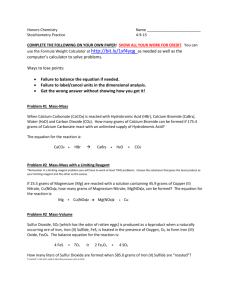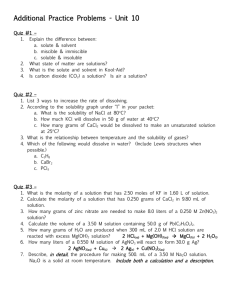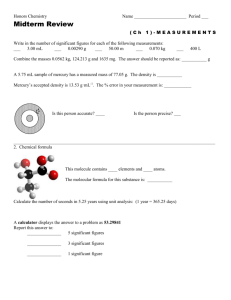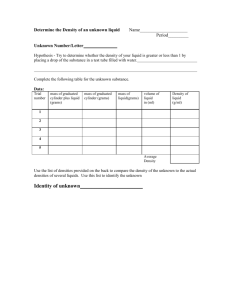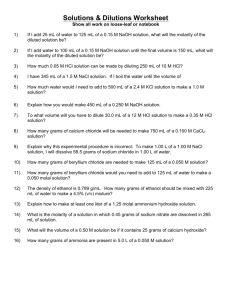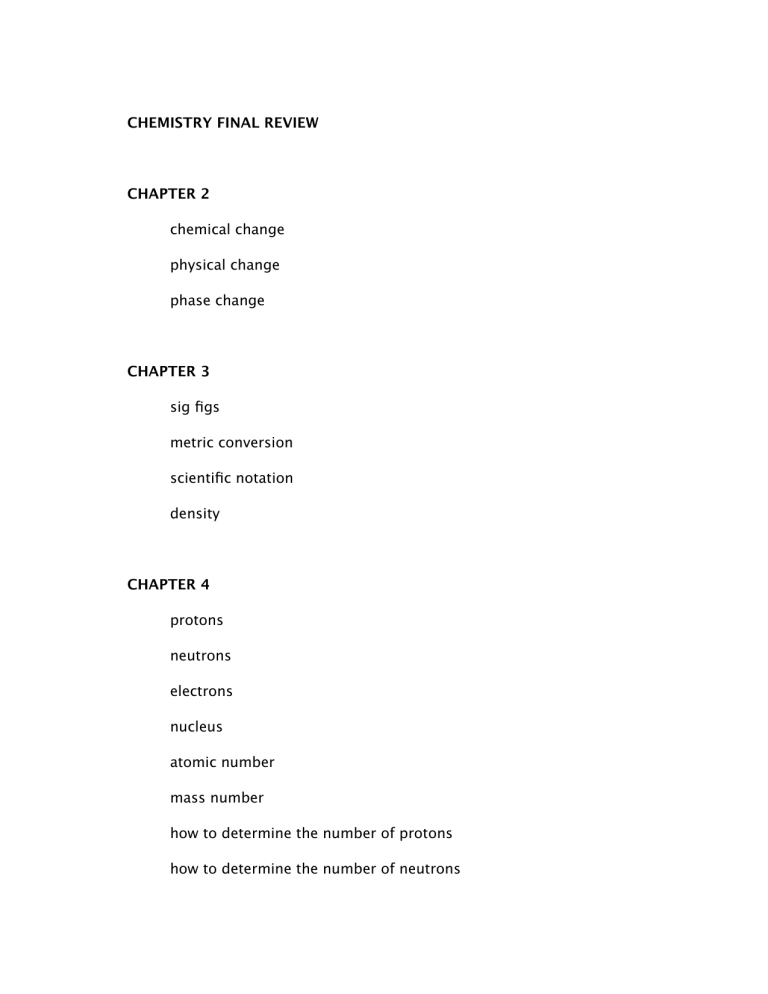
CHEMISTRY FINAL REVIEW
CHAPTER 2
chemical change
physical change
phase change
CHAPTER 3
sig figs
metric conversion
scientific notation
density
CHAPTER 4
protons
neutrons
electrons
nucleus
atomic number
mass number
how to determine the number of protons
how to determine the number of neutrons
how to determine the number of electrons
CHAPTER 5
valence electrons
principle quantum numbers
number of electrons in each orbital
how to determine the number of valence electrons
writing electron configurations
CHAPTER 6
periodic table
periodic law
metals
nonmetals
metalloids
group names
transition elements
trends :
electronegativity
atomic radius
ionization energy
CHAPTER 7
oxidation numbers
cation
anions
octet rule
properties of ionic bonds
properties of covalent bonds
CHAPTER 8
atoms
ions
molecules
diatomic molecules
molecules
molecular compounds
single bonds
double bonds
triple bonds
shape of s orbital
shape of p orbital
shape of d orbital
Polarity
Van der waals forces
dipoles
dispersion forces
hydrogen bonds
CHAPTER 9
polyatomic ions
naming and writing formulas
acids and bases
CHAPTER 10
moles
mole roadmap
conversions
% composition
CHAPTER 11
balancing equations
writing equations
types of reactions:
combustion
decomposition
single replacement
double replacement
synthesis
net ionic equations
CHAPTER 12
stoichiometry
mass-mass problems
Unit Conversions Worksheet
1)
How many inches are there in 45.6 cm? (There are 2.54 cm in 1 inch)
2)
How many centimeters are there in 1.23 x 10-6 kilometers?
3)
How many hours are there in 34.5 years?
4)
How many inches are there in 355 millimeters?
5)
How many milliliters are in a cubic meter? (There are 1,000 L in 1 m3)
6)
How many miles are there in 3.44 x 108 inches? There are 0.61 miles in 1
km).
Need help with chemistry? Visit www.chemfiesta.com!
Unit Conversions Worksheet - Solutions
1)
How many inches are there in 45.6 cm? (There are 2.54 cm in 1 inch)
18.0 inches
2)
How many centimeters are there in 1.23 x 10-6 kilometers?
0.123 cm
3)
How many hours are there in 34.5 years?
3.02 x 105 hours
4)
How many inches are there in 355 millimeters?
14.0 inches
5)
How many milliliters are in a cubic meter? (There are 1,000 L in 1 m3)
1.00 x 106 mL
6)
How many miles are there in 3.44 x 108 inches? There are 0.61 miles in 1
km).
5.33 x 103 miles
Need help with chemistry? Visit www.chemfiesta.com!
Significant Figures Practice Worksheet
How many significant figures do the following numbers have?
1)
1234 _____
2)
0.023 _____
3)
890 _____
4)
91010 _____
5)
9010.0 _____
6)
1090.0010 _____
7)
0.00120 _____
8)
3.4 x 104 _____
9)
9.0 x 10-3 _____
10)
9.010 x 10-2 _____
11)
0.00030 _____
12)
1020010 _____
13)
780. _____
14)
1000 _____
15)
918.010 _____
16)
0.0001 _____
17)
0.00390 _____
18)
8120 _____
19)
7.991 x 10-10_____
20)
72 _____
http://www.chemfiesta.com
Solutions to the Significant Figures Practice Worksheet
1)
2)
3)
4)
5)
6)
7)
8)
9)
10)
11)
12)
13)
14)
15)
16)
17)
18)
19)
20)
4
2
2
4
5
8
3
2
2
4
2
6
3
1
6
1
3
3
4
2
http://www.chemfiesta.com
Significant Figure Calculations
Solve the following mathematical problems such that the answers have the
correct number of significant figures:
1)
334.54 grams + 198 grams = ___________________
2)
34.1 grams / 1.1 mL = ___________________
3)
2.11 x 103 joules / 34 seconds = ___________________
4)
0.0010 meters – 0.11 m = ___________________
5)
349 cm + 1.10 cm + 100 cm = ___________________
6)
450 meters / 114 seconds = ___________________
7)
298.01 kilograms + 34.112 kilograms = ___________________
8)
84 m/s x 31.221 s = ___________________
www.chemfiesta.com
© 2008 Cavalcade Publishing; All Rights reserved
Significant Figure Calculations – Answers
Solve the following mathematical problems such that the answers have the
correct number of significant figures:
1)
334.54 grams + 198 grams = 533 grams (rounded from 532.42 grams)
2)
34.1 grams / 1.1 mL = 31 g/mL (not rounded)
3)
2.11 x 103 joules / 34 seconds = 62 J/s (rounded from 62.0588 J/s)
4)
0.0010 meters – 0.11 m = -0.11 m (rounded from -0.109 m)
5)
349 cm + 1.10 cm + 100 cm = 500 cm (rounded from 450.1 cm)
6)
450 meters / 114 seconds = 3.9 m/s (rounded from 3.9474 m/s)
7)
298.01 kilograms + 34.112 kilograms = 332.12 kg (rounded from 332.122
kg)
8)
84 m/s x 31.221 s = 2600 m (rounded from 2622.564 m)
www.chemfiesta.com
© 2008 Cavalcade Publishing; All Rights reserved
Scientific Notation Worksheet
Convert the following numbers into scientific notation:
1)
3,400 _______________________________
2)
0.000023 _______________________________
3)
101,000 _______________________________
4)
0.010 _______________________________
5)
45.01 _______________________________
6)
1,000,000 _______________________________
7)
0.00671 _______________________________
8)
4.50 _______________________________
Convert the following numbers into standard notation:
9)
2.30 x 104 _______________________________
10)
1.76 x 10-3 _______________________________
11)
1.901 x 10-7 _______________________________
12)
8.65 x 10-1 _______________________________
13)
9.11 x 103 _______________________________
14)
5.40 x 101 _______________________________
15)
1.76 x 100 _______________________________
16)
7.4 x 10-5 _______________________________
For chemistry help, visit www.chemfiesta.com
© 2003 Cavalcade Publishing – All Rights Reserved
Scientific Notation Worksheet - Solutions
Convert the following numbers into scientific notation:
1)
3,400
3.4 x 103
2)
0.000023
2.3 x 10-5
3)
101,000
1.01 x 105
4)
0.010
1.0 x 10-2
5)
45.01
4.501 x 101
6)
1,000,000
1 x 106
7)
0.00671
6.71 x 10-3
8)
4.50
4.50 x 100
Convert the following numbers into standard notation:
9)
2.30 x 104
23,000
10)
1.76 x 10-3
0.00176
11)
1.901 x 10-7 0.0000001901
12)
8.65 x 10-1
0.865
13)
9.11 x 103
9,110
14)
5.40 x 101
54.0
15)
1.76 x 100
1.76
16)
7.4 x 10-5
0.000074
For chemistry help, visit www.chemfiesta.com
© 2003 Cavalcade Publishing – All Rights Reserved
Electron Configuration Practice Worksheet
In the space below, write the unabbreviated electron configurations of the
following elements:
1)
sodium
________________________________________________
2)
iron
________________________________________________
3)
bromine
________________________________________________
4)
barium
________________________________________________
5)
neptunium
________________________________________________
In the space below, write the abbreviated electron configurations of the following
elements:
6)
cobalt
________________________________________________
7)
silver
________________________________________________
8)
tellurium
________________________________________________
9)
radium
________________________________________________
10)
lawrencium ________________________________________________
Determine what elements are denoted by the following electron configurations:
11)
1s22s22p63s23p4 ____________________
12)
1s22s22p63s23p64s23d104p65s1 ____________________
13)
[Kr] 5s24d105p3 ____________________
14)
[Xe] 6s24f145d6 ____________________
15)
[Rn] 7s25f11 ____________________
Determine which of the following electron configurations are not valid:
16)
1s22s22p63s23p64s24d104p5 ____________________
17)
1s22s22p63s33d5 ____________________
18)
[Ra] 7s25f8 ____________________
19)
[Kr] 5s24d105p5 ____________________
20)
[Xe] ____________________
Need homework help? Visit www.chemfiesta.com !
Need homework help? Visit www.chemfiesta.com !
Electron Configurations - Solutions
Note: The electron configurations in this worksheet assume that lanthanum (La)
is the first element in the 4f block and that actinium (Ac) is the first element in the
5f block. If your periodic table doesn’t agree with this, your answers for elements
near the f-orbitals may be slightly different.
1)
sodium
1s22s22p63s1
2)
iron
1s22s22p63s23p64s23d6
3)
bromine
1s22s22p63s23p64s23d104p5
4)
barium
1s22s22p63s23p64s23d104p65s24d105p66s2
5)
neptunium
1s22s22p63s23p64s23d104p65s24d105p66s24f145d106p67s25f5
6)
cobalt
[Ar] 4s23d7
7)
silver
[Kr] 5s24d9
8)
tellurium
[Kr] 5s24d105p4
9)
radium
[Rn] 7s2
10)
lawrencium [Rn] 7s25f146d1
11)
1s22s22p63s23p4 sulfur
12)
1s22s22p63s23p64s23d104p65s1 rubidium
13)
[Kr] 5s24d105p3 antimony
14)
[Xe] 6s24f145d6 osmium
15)
[Rn] 7s25f11 einsteinium
16)
1s22s22p63s23p64s24d104p5 not valid (take a look at “4d”)
17)
1s22s22p63s33d5 not valid (3p comes after 3s)
18)
[Ra] 7s25f8 not valid (radium isn’t a noble gas)
19)
[Kr] 5s24d105p5 valid
20)
[Xe] not valid (an element can’t be its own electron configuration)
Need homework help? Visit www.chemfiesta.com !
Protons, Neutrons, and Electrons Practice
Worksheet
Fill in the blanks in the following worksheet. Please keep in mind that the isotope
represented by each space may NOT be the most common isotope or the one
closest in atomic mass to the value on the periodic table.
Atomic
symbol
Atomic
number
Protons Neutrons Electrons
B
Atomic
mass
6
11
24
31
37
39
29
89
35
43
100
207
Pb
102
89
Mo
70
225
53
81
100
206
159
No
Yb
261
172
106
http://www.chemfiesta.com
159
Solutions for the Protons, Neutrons, and Electrons Practice Worksheet:
Atomic
symbol
Atomic
number
B
Na
Ga
Y
Cu
Tc
Pb
Yb
Ac
Mo
Tl
Fm
No
Yb
Sg
5
11
31
39
29
43
82
70
89
42
81
100
102
70
106
http://www.chemfiesta.com
Protons Neutrons Electrons
5
11
31
39
29
43
82
70
89
42
81
100
102
70
106
6
13
37
50
35
57
125
102
136
53
125
159
159
101
159
5
11
31
39
29
43
82
70
89
42
81
100
102
70
106
Atomic
mass
11
24
68
89
64
100
207
172
225
95
206
259
261
172
265
CHEMISTRY REVIEW WORKSHEET
1. The atomic number of an element is __________________________?
Does this number ever change for atoms of the same element?
2. The atomic mass number of an element is ___________________________?
If this number changes for an atom of a specific element you have an (ion, isotope)
___________________? Has the number of protons or neutrons changed?
3. When an element exists in nature by itself, it must have a charge of ________?
When that charge changes to become either plus or minus, you have changed the
number of ___________________?
If the charge becomes minus, you have (more or less) ____________ electrons than protons?
4. An atom has 7 protons, 7 electrons, and 8 neutrons. Fill in the blanks below for this atom:
Atomic Number _______ Atomic mass: _______ Charge: ________
This atom belongs to which element?
5. An ion of oxygen has a charge of –2. How many protons and electrons does the ion have?
Protons ______________ Electrons ______________
6. An ion of potassium has a charge of +1. How many protons and electrons does this ion have?
Protons ______________ Electrons ______________
7. The mineral fluorite is made of fluorine and calcium. Use the periodic table of the elements to
determine what charge each of these elements will take in order to form a compound.
Charge on fluorine _________ Charge on calcium __________
Using this information, write a chemical formula for the compound, which makes up
fluorite:
8. The element oxygen will always take a charge of –2 in naturally occurring rocks and minerals.
The chemical formula for the compound, which makes up the mineral quartz, is SiO2. What is the
charge of silicon in this compound?
9. An atom has 6 protons, 7 neutrons, and 6 electrons. Fill in the blanks below for this atom:
Atomic number _____ Atomic mass number _____ Charge ______
This atom belongs to which element?
10. A calcium ion has a charge of +2. How many protons and electrons does it have?
Protons ______________ Electrons ______________
Molar Mass Practice Worksheet
Find the molar masses of the following compounds:
1)
NaBr
2)
PbSO4
3)
Ca(OH)2
4)
Na3PO4
5)
(NH4)2CO3
6)
C6H12O6
7)
Fe3(PO4)2
8)
(NH4)2S
9)
Zn(C2H3O2)2
10)
AgF
http://www.chemfiesta.com
Solutions to the Molar Mass Practice Worksheet:
Important note to students: All of the units given here are “grams per mole”,
which may be abbreviated as “g/mol”, “grams/mol”, or “g . mol-1”, depending on
how your teacher likes to see it written. They all mean the same thing, but it’s
probably a good idea to use whatever your teacher showed you in class. Also,
remember that if you don’t use units in your answer, the answer is wrong!
All answers are rounded to the nearest 0.1 grams.
1)
2)
3)
4)
5)
6)
7)
8)
9)
10)
102.9 g/mol
303.3 g/mol
74.1 g/mol
164.0 g/mol
96.0 g/mol
180.0 g/mol
357.4 g/mol
68.1 g/mol
183.4 g/mol
126.9 g/mol
http://www.chemfiesta.com
Balancing Equations Practice Worksheet
Balance the following equations:
1)
___ NaNO3 + ___ PbO ! ___ Pb(NO3)2 + ___ Na2O
2)
___ AgI + ___ Fe2(CO3)3 ! ___ FeI3 + ___ Ag2CO3
3)
___ C2H4O2 + ___ O2 ! ___ CO2 + ___ H2O
4)
___ ZnSO4 + ___ Li2CO3 ! ___ ZnCO3 + ___ Li2SO4
5)
___ V2O5 + ___ CaS ! ___ CaO + ___ V2S5
6)
___ Mn(NO2)2 + ___ BeCl2 ! ___ Be(NO2)2 + ___ MnCl2
7)
___ AgBr + ___ GaPO4 ! ___ Ag3PO4 + ___ GaBr3
8)
___ H2SO4 + ___ B(OH)3 ! __ B2(SO4)3 + ___ H2O
9)
___ S8 + ___ O2 ! ___ SO2
10)
___ Fe + ___ AgNO3 ! ___ Fe(NO3)2 + ___ Ag
http://www.chemfiesta.com
Solutions for the Balancing Equations Practice Worksheet
1)
2 NaNO3 + PbO ! Pb(NO3)2 + Na2O
2)
6 AgI + Fe2(CO3)3 ! 2 FeI3 + 3 Ag2CO3
3)
C2H4O2 + 2 O2 ! 2 CO2 + 2 H2O
4)
ZnSO4 + Li2CO3 ! ZnCO3 + Li2SO4
5)
V2O5 + 5 CaS ! 5 CaO + V2S5
6)
Mn(NO2)2 + BeCl2 ! Be(NO2)2 + MnCl2
7)
3 AgBr + GaPO4 ! Ag3PO4 + GaBr3
8)
3 H2SO4 + 2 B(OH)3 ! B2(SO4)3 + 6 H2O
9)
S8 + 8 O2 ! 8 SO2
10)
Fe + 2 AgNO3 ! Fe(NO3)2 + 2 Ag
http://www.chemfiesta.com
Fun With Predicting Reaction Products
Predict the products of each of the following chemical reactions. If a reaction will
not occur, explain why not:
1)
____ Ag2SO4 + ____ NaNO3 !
2)
____ NaI + ____ CaSO4 !
3)
____ HNO3 + ____ Ca(OH)2 !
4)
____ CaCO3 !
5)
____ AlCl3 + ____ (NH4)PO4 !
6)
____ Pb + ____ Fe(NO3)3 !
7)
____ C3H6 + ____ O2 !
8)
____ Na + ____ CaSO4 !
Fun With Predicting Reaction Products – Answers
Predict the products of each of the following chemical reactions. If a reaction will
not occur, explain why not:
Before moving on, here are some general rules of thumb for how to figure
out what will be made (and if the reaction will occur at all):
1)
If something that has carbon and hydrogen reacts with oxygen, it’s
probably a combustion reaction. The products will be CO2 and H2O.
2)
If two elements or very simple molecules combine with each other,
it’s probably a synthesis reaction. The products will probably be
predictable using the octet rule to find charges.
3)
If one compound has an arrow coming off of it, it’s probably a
decomposition reaction. The products will either be a couple of very
simple molecules, or some elements, or both.
4)
If a pure element reacts with another compound (usually, but not
always, ionic), it’s probably a single displacement reaction. The
products will be the compounds formed when the pure element
switches places with another element in the other compound.
Important note: these reactions will only occur if the pure element on the
reactant side of the equation is higher on the activity series than the
element it replaces.
•
5)
•
6)
If two ionic compounds combine, it’s probably a double
displacement reaction. Switch the cations and balance out the
charges to figure out what will be made.
Important note: These reactions will only occur if both reactants are
soluble in water and only one product is soluble in water.
If an acid and a base combine, it’s an acid-base reaction. The
products will be an ionic compound and water.
On the next page are explanations of how this works in sample problems:
1)
____ Ag2SO4 + ____ NaNO3 ! no reaction!
Examining this reaction, it appears that a double displacement reaction will
occur. This would lead to the conclusion that the products would be
AgNO3 and Na2SO4. However, for this reaction to occur, both reactants and
only one of the products must be soluble in water. If you look up the
solubilities on a chart, you’ll find that Ag2SO3 is partly soluble in water, and
all of the other compounds are totally soluble in water. This tells us that
this reaction will not occur.
2)
____ NaI + ____ CaSO4 ! no reaction!
Another double displacement reaction, this time with Na2SO4 and CaI2 as
products. Because both products are soluble in water and CaSO4 is only
partially soluble in water, the conditions for a successful double
displacement reaction are not met.
3)
2 HNO3 + 1 Ca(OH)2 ! 1 Ca(NO3)2 + 2 H2O
It’s an acid-base reaction, and acid-base reactions occur readily whether or
not the reactants are both soluble in water.
4)
1 CaCO3 ! 1 CaO + 1 CO2
It’s a decomposition reaction. If you didn’t guess that these were the
products, you should have at least known that it was a decomposition
reaction and predicted that this would have broken into its constituent
elements, Ca, C, and O2.
5)
1 AlCl3(aq) + 1 (NH4)3PO4(aq) ! AlPO4(s) + 3 NH4Cl(aq)
This is a double displacement reaction, except in this case both of the
reactants and only one product are soluble in water. Because the
conditions for a successful reaction are met, the reaction does occur!
6)
____ Pb + ____ Fe(NO3)3 ! no reaction!
Though this is a single displacement reaction, lead is lower on the activity
series than the iron it would replace. As a result, this reaction does not
occur.
7)
2 C3H6 + 9 O2 ! 6 CO2 + 6 H2O
The reactants suggest that this is a combustion reaction, meaning that the
products must be carbon dioxide and water. Once you figure this out, the
only thing left to do is balance it, as shown.
8)
2 Na + 1 CaSO4 ! 1 Na2SO4 + 1 Ca
This should clearly be a single displacement reaction. Because sodium is
higher on the activity series than calcium, this reaction does occur.
Mole Calculation Practice Worksheet
Answer the following questions:
1)
How many moles are in 25 grams of water?
2)
How many grams are in 4.5 moles of Li2O?
3)
How many molecules are in 23 moles of oxygen?
4)
How many moles are in 3.4 x 1023 molecules of H2SO4?
5)
How many molecules are in 25 grams of NH3?
6)
How many grams are in 8.2 x 1022 molecules of N2I6?
http://www.chemfiesta.com
http://www.chemfiesta.com
Solutions for the mole calculation practice worksheet:
1)
2)
3)
4)
5)
6)
1.39 moles
134.1 grams
1.38 x 1025 molecules
0.56 moles
8.85 x 1023 molecules
106.7 grams
http://www.chemfiesta.com
Percent Composition Worksheet
Find the percent compositions of all of the elements in the following compounds:
1)
CuBr2
Cu: ___________
Br: ___________
2)
NaOH
Na: ___________
O: ___________
H: ___________
3)
(NH4)2S
N: ___________
H: ___________
S: ___________
4)
N2S2
N: ___________
S: ___________
For chemistry help, visit www.chemfiesta.com
© 2002 Cavalcade Publishing – All Rights Reserved
Percent Composition Worksheet - Solutions
Find the percent compositions of all of the elements in the following compounds:
1)
CuBr2
Cu: 28.4%
Br: 71.6%
2)
NaOH
Na: 57.5%
O: 40.0%
H: 2.5%
3)
(NH4)2S
N: 41.1%
H: 11.8%
S: 47.1%
4)
N2S2
N: 30.4%
S: 69.6%
For chemistry help, visit www.chemfiesta.com
© 2002 Cavalcade Publishing – All Rights Reserved
Percent Yield Calculations
1)
Balance this equation and state which of the six types of reaction is taking
place:
____ Mg + ____ HNO3 ! ____ Mg(NO3)2 + ____ H2
Type of reaction: __________________________
2)
If I start this reaction with 40 grams of magnesium and an excess of nitric
acid, how many grams of hydrogen gas will I produce?
3)
If 1.7 grams of hydrogen is actually produced, what was my percent yield
of hydrogen?
4)
Balance this equation and state what type of reaction is taking place:
____ NaHCO3 ! ____ NaOH + ____ CO2
Type of reaction: __________________________
5)
If 25 grams of carbon dioxide gas is produced in this reaction, how many
grams of sodium hydroxide should be produced?
6)
If 50 grams of sodium hydroxide are actually produced, what was my
percent yield?
For chemistry help, visit www.chemfiesta.com
© 2007 Cavalcade Publishing, All Rights Reserved
Percent Yield Calculation Answers
1)
Balance this equation and state which of the six types of reaction is taking
place:
1 Mg + 2 HNO3 ! 1 Mg(NO3)2 + 1 H2
Type of reaction: single displacement
2)
If I start this reaction with 40 grams of magnesium and an excess of nitric
acid, how many grams of hydrogen gas will I produce?
• 3.3 grams (when Mg atomic mass = 24.3 grams)
3)
If 1.7 grams of hydrogen is actually produced, what was my percent yield
of hydrogen?
• 52%
4)
Balance this equation and state what type of reaction is taking place:
1 NaHCO3 ! 1 NaOH + 1 CO2
Type of reaction: decomposition
5)
If 25 grams of carbon dioxide gas is produced in this reaction, how many
grams of sodium hydroxide should be produced?
22.7 grams NaOH
6)
If 50 grams of sodium hydroxide are actually produced, what was my
percent yield?
50/22.7 x 100% = 220%
Hopefully, you understand that this is not a reasonable answer to
this question and indicates that something very wrong happened
during this reaction.
For chemistry help, visit www.chemfiesta.com
© 2007 Cavalcade Publishing, All Rights Reserved
Stoichiometry Review – Ch. 9
**YOUR ANSWERS MUST INCLUDE THE PROPER NUMBER OF SIG FIGS AND
COMPLETE UNITS IN ORDER TO RECEIVE CREDIT FOR THE PROBLEM.**
BALANCE THE FOLLOWING EQUATIONS TO USE IN QUESTIONS 5 – 14:
1. ____ Al + ____ O2 → ____ Al2O3
2. ____ Cu + ____ AgNO3 → ____ Ag + ____ Cu(NO3)2
3. ____ Zn + ____ HCl → ____ ZnCl2 + ____ H2
4. ____ Fe + ____ Cl2 → ____ FeCl3
PERFORM THE FOLLOWING STOICHIOMETRIC CALCULATIONS:
5. Zinc reacts with hydrochloric acid to produce zinc chloride and hydrogen. How
many moles of HCl are required to produce 7.50 moles of ZnCl2?
6. Copper metal reacts with silver nitrate to form silver and copper(II) nitrate. How
many grams of copper are required to form 250 g of silver?
7. When aluminum is burned in excess oxygen, aluminum oxide is produced. How
many grams of oxygen are required to produce 0.75 moles of Al2O3?
8. How many grams of iron(III) chloride are produced when 15.3 g of iron react with
excess chlorine gas?
9. Copper metal reacts with silver nitrate to form silver and copper(II) nitrate. How
many moles of silver will be produced from 3.65 moles of silver nitrate?
10. Zinc reacts with hydrochloric acid to produce zinc chloride and hydrogen gas.
How many milliters of 3.00M HCl are required to react with 12.35 g of zinc?
11. How many grams of iron are needed to react with 31.0 L of chlorine gas at STP
to produce iron(III) chloride?
12. When 9.34 g of zinc react with excess hydrochloric acid how many grams of zinc
chloride will be produced?
13. How many liters of oxygen gas at STP are required to react with 65.3 g of
aluminum in the production of aluminum oxide?
14. Copper reacts with silver nitrate to form silver and copper(II) nitrate. How many
grams of copper are required to react with 50.0 mL of 8.0M AgNO3?
15. Nickel nitrate and potassium carbonate react to form nickel carbonate and
potassium nitrate. How many milliliters of 0.55M Ni(NO3)2 are needed to react
with 85 mL of 0.25M K2CO3? First, write a balanced equation.
C. Johannesson
16. Zinc metal reacts with chromium(III) nitrate in a single replacement reaction.
How many grams of zinc are required to react with 425 mL of 0.25M Cr(NO3)3?
First, write a balanced equation.
PERFORM THE FOLLOWING LIMITING REACTANT PROBLEMS:
17. When 16.3 g of magnesium and 4.52 g of oxygen gas react, how many grams of
magnesium oxide will be formed? Identify the limiting and excess reactants.
2 Mg + O2 → 2 MgO
18. If 25.3 g of aluminum reacts with 25.3 g of copper(II) sulfate, how many grams of
copper are formed? Identify the limiting and excess reactants in this single
replacement reaction.
2 Al + 3 CuSO4 → 3 Cu + Al2(SO4)3
19. Identify the limiting and excess reactants when 1.00 g of zinc reacts with 150 mL
of 0.250M Pb(NO3)2. How many grams of lead are formed in this single
replacement reaction?
Zn + Pb(NO3)2 → Pb + Zn(NO3)2
20. If 24.5 g of iron are placed in 1.00 L of 0.25M HCl, how many grams of FeCl2 are
obtained? Identify the limiting and excess reactants in this single replacement
reaction.
Fe + 2 HCl → FeCl2 + H2
PERFORM THE FOLLOWING PERCENT YIELD CALCULATIONS:
21. If 12.5 g of copper react with excess chlorine gas, then 25.4 g of copper(II)
chloride are produced. Find the theoretical and percent yields.
Cu + Cl2 → CuCl2
22. If 6.57 g of iron react with an excess of hydrochloric acid, HCl, then 11.2 g of
iron(II) chloride are obtained in addition to hydrogen gas. Find the theoretical
and percent yields.
Fe + 2 HCl → FeCl2 + H2
23. If 5.45 g of potassium chlorate are decomposed to form potassium chloride, 1.75
g of oxygen gas are also given off. Find the theoretical and percent yields.
2 KClO3 → 2 KCl + 3 O2
C. Johannesson
Stoichiometry Review – Ch. 9
ANSWER KEY
BALANCED EQUATIONS
1. 4 Al + 3 O2 → 2 Al2O3
2. Cu + 2 AgNO3 → 2 Ag + Cu(NO3)2
3. Zn + 2 HCl → ZnCl2 + H2
4. 2 Fe + 3 Cl2 → 2 FeCl3
STOICHIOMETRIC CALCULATIONS
5. 15.0 mol HCl
6. 74 g Cu
7. 36 g O2
8. 44.4 g FeCl3
9. 3.65 mol Ag
10. 126 mL HCl
11. 51.5 g Fe
12. 19.5 g ZnCl2
13. 40.7 L O2
14. 13 g Cu
15. Ni(NO3)2 + K2CO3 → NiCO3 + 2 KNO3, 39 mL Ni(NO3)2
16. 3 Zn + 2 Cr(NO3)3 → 3 Zn(NO3)2 + 2 Cr, 10. g Zn
LIMITING REACTANT
17. LR: O2
XS: Mg
Product: 11.4 g MgO
18. LR: CuSO4
XS: Al
Product: 10.0 g Cu
19. LR: Zn
XS: Pb(NO3)2
Product: 3.17 g Pb
20. LR: HCl
XS: Fe
Product: 16 g FeCl2
PERCENT YIELD
21. Theoretical: 26.4 g CuCl2
Percent Yield: 96.2%
22. Theoretical: 14.9 g FeCl2
Percent Yield: 75.1%
23. Theoretical: 2.13 g O2
Percent Yield: 82.2%
C. Johannesson
Word Equations Worksheet
Write the word equations for each of the following chemical reactions:
1)
When dissolved beryllium chloride reacts with dissolved silver nitrate in
water, aqueous beryllium nitrate and silver chloride powder are made.
2)
When isopropanol (C3H8O) burns in oxygen, carbon dioxide, water, and
heat are produced.
3)
When dissolved sodium hydroxide reacts with sulfuric acid (H2SO4),
aqueous sodium sulfate, water, and heat are formed.
4)
When fluorine gas is put into contact with calcium metal at high
temperatures, calcium fluoride powder is created in an exothermic
reaction.
5)
When sodium metal reacts with iron (II) chloride, iron metal and sodium
chloride are formed.
For chemistry help, visit www.chemfiesta.com
© 2002 Cavalcade Publishing, All Rights Reserved
Word Equations Worksheet - Solutions
Write the word equations for each of the following chemical reactions:
1)
When dissolved beryllium chloride reacts with dissolved silver nitrate in
water, aqueous beryllium nitrate and silver chloride powder are made.
BeCl2(aq) + 2 AgNO3(aq) ! Be(NO3)2(aq) + 2 AgCl(s)
2)
When isopropanol (C3H8O) burns in oxygen, carbon dioxide, water, and
heat are produced.
2 C3H8O(l) + 9 O2(g) ! 6 CO2(g) + 8 H2O(g) ΔH = negative
3)
When dissolved sodium hydroxide reacts with sulfuric acid, aqueous
sodium sulfate, water, and heat are formed.
2 NaOH(aq) + H2SO4(l) ! Na2SO4 + 2 H2O(l) ΔH = negative
4)
When fluorine gas is put into contact with calcium metal at high
temperatures, calcium fluoride powder is created in an exothermic
reaction.
Δ
F2(g) + Ca(s) ! CaF2(s) ΔH = negative
5)
When sodium metal reacts with iron (II) chloride, iron metal and sodium
chloride are formed.
2 Na(s) + FeCl2(s) ! 2 NaCl(s) + Fe(s)
For chemistry help, visit www.chemfiesta.com
© 2002 Cavalcade Publishing, All Rights Reserved


